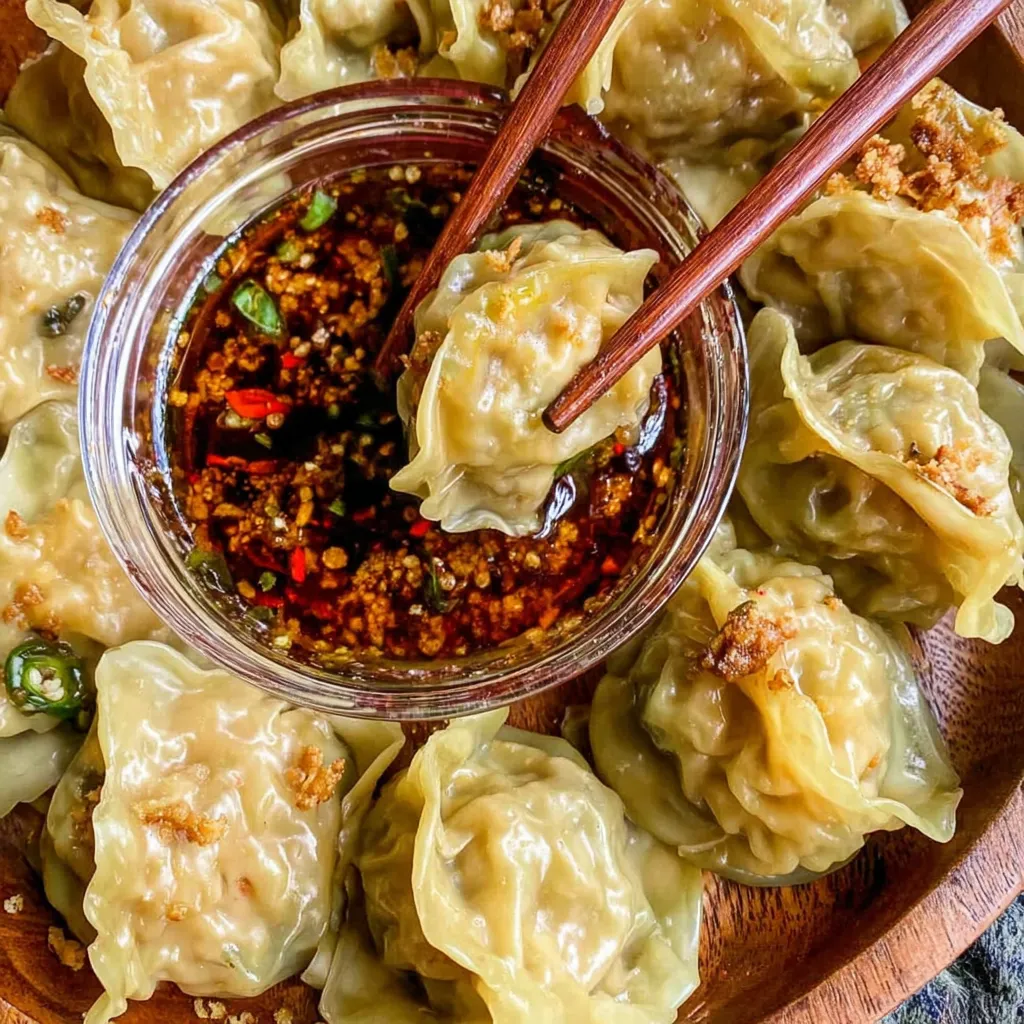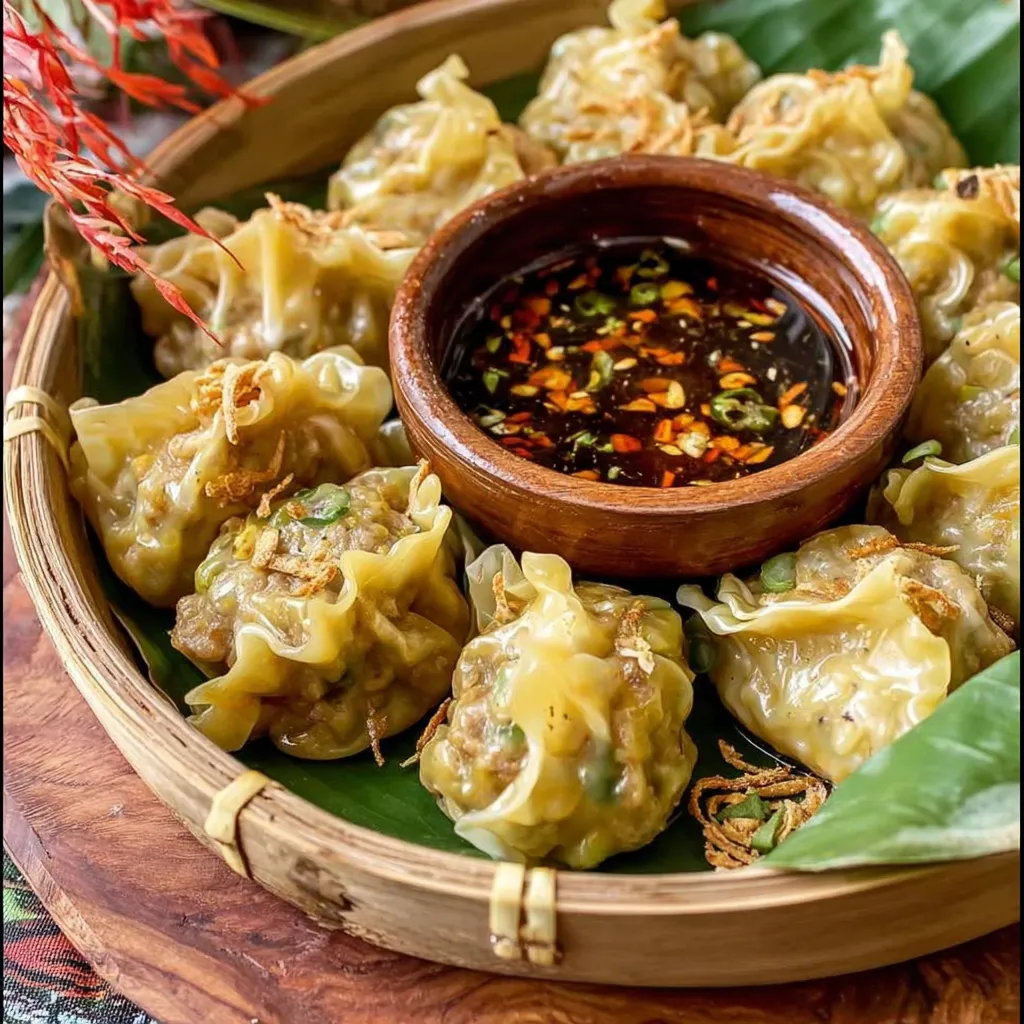 Save
Save
This flavorful kanom jeeb recipe brings authentic Thai dumplings right to your home kitchen with delicate wonton wrappers cradling a savory pork filling enhanced with aromatic herbs and seasonings. The steaming process creates perfectly tender dumplings that showcase the beautiful blend of traditional Thai flavors in every bite.
I first learned to make these dumplings from my Thai neighbor who insisted the secret was in the aromatic coriander root and proper steaming technique. After years of perfecting my technique I now make these for every gathering and they disappear within minutes.
Ingredients
- Ground pork: creates the perfect tender base for these dumplings with just the right amount of fat content for flavor
- Coriander roots: provide an irreplaceable aromatic quality that distinguishes Thai cuisine
- Dried shiitake mushrooms: add an umami depth once rehydrated and finely chopped
- Golden mountain sauce: delivers the authentic Thai flavor profile that cannot be substituted
- Dumpling wrappers: should be thin yet sturdy enough to hold the filling while steaming
- Sesame oil: brings a nutty undertone that elevates the entire flavor profile
- Crispy fried garlic: provides a textural contrast and aromatic finish that makes these dumplings special
Step-by-Step Instructions
- Create the Aromatic Base:
- Using a mortar and pestle pound the coriander roots, black peppercorns, and garlic together until they form a fine paste. This traditional method releases essential oils from these aromatics that will permeate the entire dumpling filling with authentic Thai flavor.
- Prepare the Sauce Mixture:
- In a large mixing bowl combine the golden mountain sauce, white sugar, sesame oil, and oyster sauce until well blended. This creates the umami-rich binding liquid that will season the filling perfectly and help maintain moisture during cooking.
- Process the Meat Mixture:
- Add the ground pork to a food processor along with the sauce mixture, egg, and cornstarch. Pulse until the mixture becomes smooth and cohesive but not overworked. The texture should be fine enough to easily spoon into wrappers but still maintain some texture.
- Incorporate Vegetables and Aromatics:
- Transfer the processed meat mixture to a large bowl and gently fold in the crushed aromatic paste, diced carrots, chopped green onions, and rehydrated shiitake mushrooms. Mix thoroughly to ensure even distribution of all ingredients throughout the filling.
- Shape the Dumplings:
- Place a wonton wrapper over the concave side of a tablespoon, creating a natural well. Add about a teaspoon of filling to the center, lightly moisten the edges with water, then fold the edges upward and around the filling. Pinch to seal while maintaining the spoon shape for perfect presentation.
- Steam to Perfection:
- Line your steamer with parchment paper to prevent sticking, arrange dumplings with space between them, cover and steam over medium heat for 10 minutes. The wrappers will become translucent and the filling will be thoroughly cooked when ready.

The first time I served these at a family gathering my grandmother who rarely compliments cooking asked for the recipe. She was amazed that something so delicate could carry such bold flavors and has since incorporated these dumplings into her own dinner party rotation.
Flavor Balance Secrets
The combination of golden mountain sauce and oyster sauce creates the perfect savory foundation for these dumplings. The subtle sweetness from sugar balances the saltiness while the aromatic coriander roots add the distinctive Thai flavor profile that makes kanom jeeb special. If you find the flavor too mild, consider adding a small amount of finely minced Thai chili to the filling mixture for heat that builds with each bite.
Make Ahead Options
Kanom jeeb can be fully prepared up to the shaping stage and refrigerated for 24 hours before steaming. Simply cover the shaped dumplings with a slightly damp cloth in the refrigerator to prevent them from drying out. For longer storage, arrange the uncooked dumplings in a single layer on a baking sheet, freeze until solid, then transfer to freezer bags where they will keep for up to three months. Steam directly from frozen, adding 3 to 4 minutes to the cooking time.
Serving Suggestions
While these dumplings are traditionally served with a simple soy dipping sauce enhanced with a few drops of sesame oil and thinly sliced green onions, they also pair beautifully with Thai sweet chili sauce for a sweet and spicy experience. For a complete meal, serve alongside a fresh green papaya salad and coconut rice. The contrasting textures and temperatures create a balanced dining experience that showcases the versatility of Thai cuisine.
Regional Variations
In northern Thailand, these dumplings sometimes include minced water chestnuts for added crunch, while southern variations might incorporate a small amount of curry paste into the filling for heat. Some modern interpretations include seafood like shrimp or crab meat mixed with the pork. Each region puts its own spin on this beloved street food while maintaining the distinctive pleated wrapper shape that makes kanom jeeb instantly recognizable.
Recipe FAQs
- → What are the best dipping sauces for Kanom Jeeb?
Kanom Jeeb pairs wonderfully with several dipping sauces including soy sauce, Thai sweet chili sauce, or a homemade wonton dipping sauce. For an authentic experience, try mixing soy sauce with a little vinegar, chopped garlic, and chili.
- → Can I make Kanom Jeeb ahead of time?
Yes, you can prepare the dumplings ahead of time. Assemble them completely, then either refrigerate for up to 24 hours before steaming, or freeze them uncooked on a tray until solid, then transfer to freezer bags for up to 3 months. Steam directly from frozen, adding a few extra minutes to the cooking time.
- → What can I substitute for golden mountain sauce?
If you can't find golden mountain sauce, you can substitute with a mixture of light soy sauce and a pinch of sugar. Another option is using Maggi seasoning sauce or a combination of soy sauce with a small splash of fish sauce to achieve a similar umami flavor profile.
- → What is the proper technique for sealing Kanom Jeeb dumplings?
For the distinctive Kanom Jeeb shape, place the filling in the center of the wrapper, then gather the edges upward around the filling while nestling in a tablespoon. Pinch the gathered edges together gently to seal while leaving the top slightly open, creating the characteristic purse or flower shape. The edges should stick together naturally when moistened with water.
- → What vegetables can I add to Kanom Jeeb filling?
Traditional Kanom Jeeb contains carrots, green onions, and shiitake mushrooms, but you can experiment with other finely diced vegetables like water chestnuts for crunch, bamboo shoots, cabbage, or finely chopped bok choy. Just ensure any vegetables are cut very small and relatively dry to maintain the proper filling consistency.
- → How do I know when my Kanom Jeeb are fully cooked?
Kanom Jeeb are done when the wrappers become translucent and the filling is cooked through, which typically takes about 10 minutes of steaming. The dumplings should feel firm to the touch, and if you cut one open, the pork filling should be completely cooked with no pink remaining.
